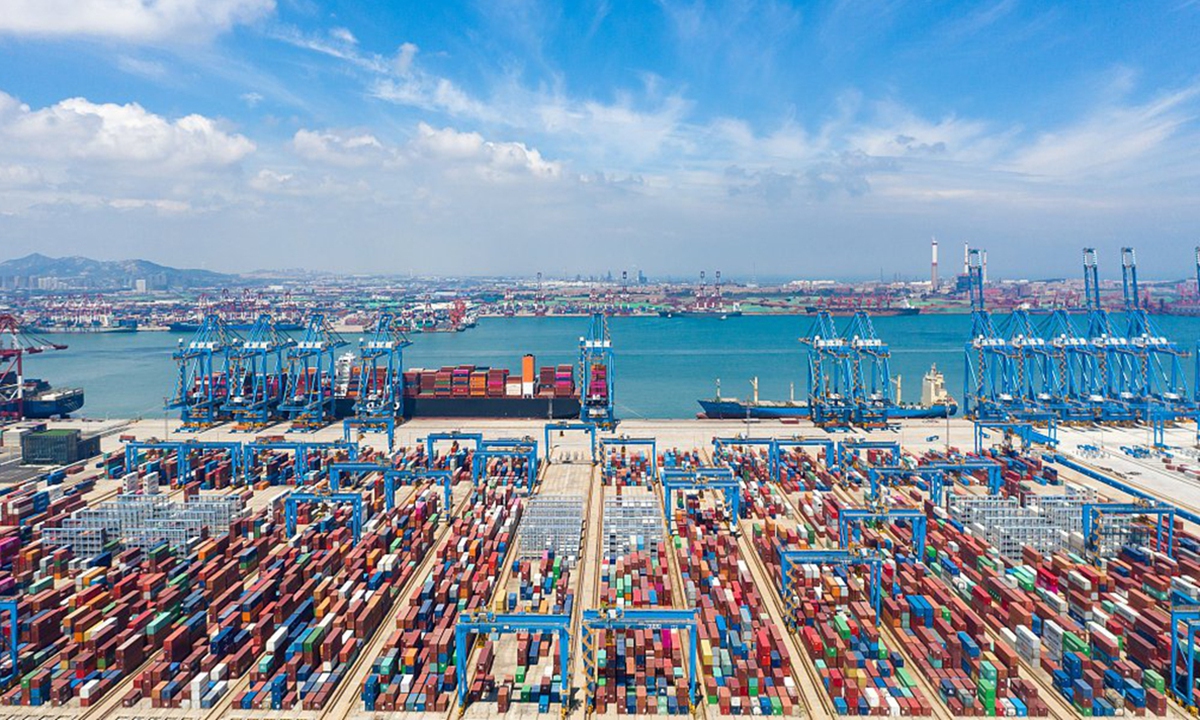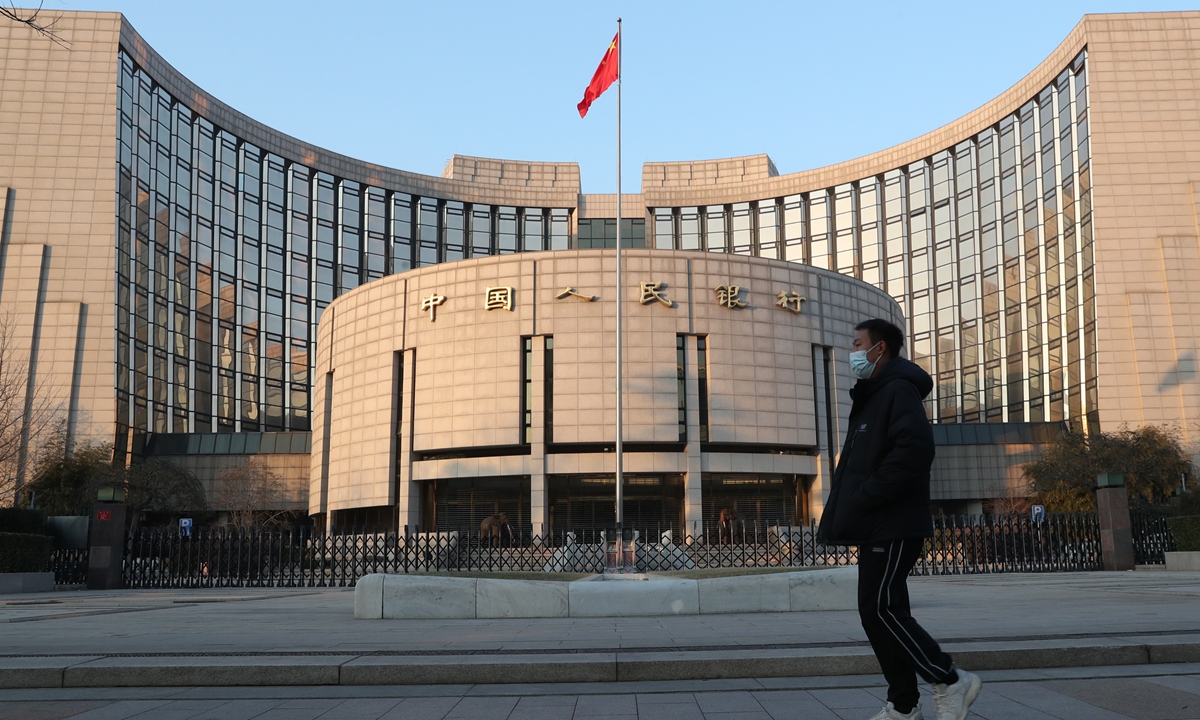
China trade economy File photo: VCG
China on Tuesday cut the benchmark lending rate loan prime rate (LPR) in line with market expectations, ending nine months without change. It marks the third effort to bring down the nation's policy rates within a week, sending a clear signal that China is resolved to spur the still unfolding economic recovery and unleash the growth potentials amid multiple downward pressures ranging from a complex global geopolitical situation and weakening world demand.
The world's second-largest economy is still firmly on course for a sustained recovery trajectory, even though some recent economic indicators have pointed to a moderate growth pace, experts stressed. The Chinese government has acted swiftly on factors challenging the economy, and it is ramping up stimulus measures to shore up market expectations and confidence, they said.
The one-year loan prime rate (LPR) came in at 3.55 percent Tuesday, down from the previous reading of 3.65 percent, according to the National Interbank Funding Center, while the over-five-year LPR, on which many lenders base their mortgage rates, was also lowered by 10 basis points to 4.2 percent.
The Tuesday cuts were widely expected as there have been frequent interest rate cuts by the People's Bank of China (PBC), the country's central bank, over the previous week. And policy rates are usually adjusted in tandem.
The PBC lowered the interest rate on its one-year medium-term lending facility (MLF) loans to financial institutions from 2.75 percent to 2.65 percent last Thursday, injecting 237 billion yuan ($33.1 billion) into markets through a liquidity instrument.
Separately, the central bank cut the seven-day reverse repo rate last Tuesday from 2 percent to 1.9 percent, injecting funds into the financial system. On the same day, the PBC also cut rates on its short-term standing lending facility by 10 basis points.

China's central bank Photo: CFP
"The adjustment on Tuesday carries a direction-pointing significance," Yan Yuejin, research director at the Shanghai-based E-house China R&D Institute, said in a note sent to the Global Times on Tuesday.
"It has positively responded to the spirit of the recent State Council executive meeting. It is the first card in a package of stimulus plans, meaning that decisive moves to lift economic activity have fully begun," Yan noted.
China is mulling policies to promote a sustained recovery of its economy, according to the State Council executive meeting chaired by Premier Li Qiang on Friday. The meeting adopted an action plan to support financing for technology-based enterprises and a draft regulation on the supervision and administration of private investment funds.
"The rates cut has substantial significance for the reduction of medium- and long-term loan costs, which means that subsequent efforts will continue to be made in reducing costs across the real economy, conducive to enhancing market expectations and confidence," Yan said.
Full-swing recovery underwayChina's recent slew of moves to trim policy rates come amid a stable yet relatively moderate recovery pace of the economy, as the real estate market continues to exert a drag on investment since the start of the second quarter.
China's three major economic indexes saw moderate growth in May, slightly missing market expectations, with industrial output rising 3.5 percent and retail sales expanding 12.7 percent on a yearly basis, data from the National Bureau of Statistics (NBS) showed.
Fixed-assets investment also slowed mainly due to the real estate sector, where investment in the first five months of the year declined 7.2 percent on a yearly basis, extending the 6.2 percent fall registered in the January-April period.
"We can't deny that China's economy is firmly making headway in its recovery trajectory, despite factors exerting a drag on the process, which is natural," Lian Ping, chief economist and head of the Zhixin Investment Research Institute, told the Global Times on Tuesday, defying Western media hype that seeks to disparage the potential and momentum of the still unfolding economic recovery.
Efforts to unleash domestic demand and stabilize market expectations and confidence are crucial for the economic rebound at present, and stimulus packages should aim in this direction, according to Lian.
This echoes the opinion of Li Daokui, director of Tsinghua University's Academic Center for Chinese Economic Practice and Thinking, who believes there is still huge potential for domestic economic growth.
"There are two key ways to boost confidence. One is to introduce policies to boost consumer confidence as soon as possible, while the other is to stimulate investment by private enterprises by offering reassurance to them," Li said at a forum on Saturday.
Consumption, for example, will play more of a driving force for economic growth by expanding domestic demand, with more stimulus measures to be rolled out by local governments in the summer, a traditional consumption peak, Lian noted.
"For the full year, consumption will be a highlight among the economic indicators," he added.In the first five months of the year, total consumer retail spending hit 18.76 trillion yuan ($2.6 trillion), up 9.3 percent from a year ago, accelerating 0.8 percentage points compared with that of the January-April period and 3.5 percentage points compared with that of the first quarter, NBS data revealed.

People take part in a dragon boat racing in Guangzhou, south China's Guangdong Province, June 15, 2023. Photo:Xinhua
The upcoming Dragon Boat Festival holidays from Thursday to Saturday are also expected to inject momentum into domestic spending following the stellar May Day holiday performance when trips and revenues both surpassed pre-COVID levels.
"With the implementation of policy interest rate cuts and other stimulus measures in the pipeline in the remainder of the year, the process of widening access to credit will speed up, which will accumulate strength for the economic recovery in the third quarter," Wang Qing, chief macroeconomic analyst at Golden Credit Rating International, told the Global Times on Tuesday.
"Multiple localities are likely to further increase the issuance of consumption vouchers and consumption subsidies to enhance residents' consumption capacity, and the focal points would be on new-energy vehicles, smart home appliances, green building materials and other bulk consumption areas," Wang said.
In terms of macro adjustment, there is still the possibility of further interest rate cuts and reserve requirement ratio (RRR) cuts in the remainder of this year, according to an analysis note sent by CITIC Securities.
Foreign-invested capital is also rooting for the recovery prospect of the Chinese market, as reflected by a stream of visits by multinational executives to the country in search of cooperation since the start of the year, including most recently, Bill Gates, co-founder of Microsoft and co-chair of the Bill & Melinda Gates Foundation, and Tesla CEO Elon Musk.
From January to May this year, a total of 18,532 foreign-invested enterprises were newly established across the nation, up 38.3 percent year-on-year, data from the Ministry of Commerce showed.






